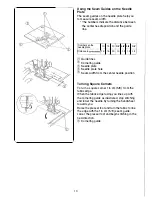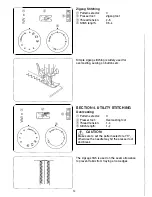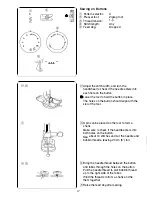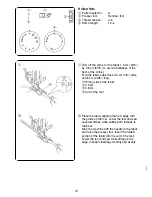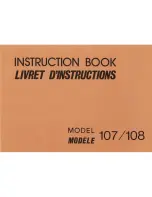
Light
weight
Medium
weight
Heavy
weight
Fabrics
-----
- ----------
Crepe de Chine, Voile,
Lawn, Organdy,
Georgette,
Tricot
- --------------
Linens1 Cotton, Pique,
Serge, Double Knits,
Percale
Denim, Tweed,
Gabardine,
Coating, Drapery and
Upholstery
Fabric
Thread
Fine Silk
Fine Cotton
Fine Synthetic
Fine Cotton
Covered
Polyester
50
silk
50
to
BO
Cotton
50
to
60
Synthetic
Cotton Covered
Polyester
50
silk
40
to
50
Cotton
40
to
50
Synthetic
Cotton Covered
Polyester
Size
9
o r
11
11
or
14
14
16
5
Changing Needle
Raise the needle by turning the handwheel
toward you and lower the presser foot.
Loosen the needle clamp screw by turning it
counterclockwise.
Remove the needle from the clamp.
Insert the new needle into the clamp with the flat
side away from you.
When inserting the needle into the clamp, push
it up as far as it will go and tighten the clamp
screw firmly with the screwdriver.
*
Check your needles frequently for barbed or
blunted points. Snags and runs in knits, fine
silks and silk-like fabrics are permanent and
are almost always caused by a damaged
needle.
To check the Needle
Place the flat side of the needle on something flat
(needle plate, glass etc.). The clearance between
the needle and flat surface should be consistent.
Never use a bent or blunt needle.
Thread and Needle Chart
* In general, fine threads and needles are used
for sewing thin fabrics, and thicker threads
and needles are used for sewing heavy
fabrics. Always test thread and needle size
on a small piece of fabric which will be used for
actual sewing.
•
Use the same thread for needle and bobbin.
•
When sewing stretch, very fine fabrics and
synthetics, use a BLUE TIPPED needle.
The blue tipped needle effectively prevents
skipped stitches.
•
When sewing very fine fabrics, sew over a piece
of paper to prevent seam puckering.



















